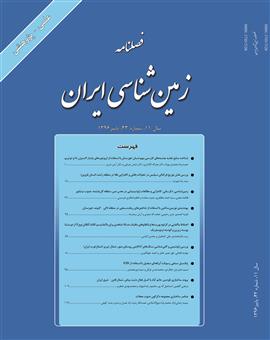تحلیل کرنش نهایی (Finite strain analysis) در سنگهای دگرریخت شده ناحیه قاسمآباد، شمال باختر بلوک لوت
محورهای موضوعی :فرید رحیمي دهگلان 1 , محمدرضا شیخ الاسلامی 2 , جعفر طاهری 3 , محمدرضا قاسمی 4
1 - سازمان زمینشناسی و اکتشافات معدنی کشور
2 - سازمان زمین شناسی کشور
3 - سازمان زمينشناسي و اکتشافات معدنی کشور، مدیریت شمال شرق
4 - سازمان زمینشناسی و اکتشافات معدنی کشور
کلید واژه: قاسمآباد پهنه زمینساختی کاشمر-کرمان ریزساختار کرنش نهایی بیضوی شدگی ,
چکیده مقاله :
سنگهای دگرریخت شده ناحیه قاسمآباد در شمال خاوری پهنه زمین ساختی کاشمر-کرمان و در بخش شمال باختری بلوک لوت قرار دارند. در این پژوهش بر پایه ی مطالعات ریزساختاری واحدهای سنگی دگرریخت شده، کرنش نهایی دوبعدی و سهبعدی بررسی شده است. روش فرای برای بررسی دوبعدی بیضوی کرنش مورد استفاده قرار گرفته و نتایج حاصل از آن برای تحلیل سهبعدی بیضوی کرنش با بهره گیری از نمودار اصلاح شده فلین بهکاربرده شده است. میانگین بیضوی شدگی بهدستآمده برای ناحیه 91/1 میباشد که در ناحیهی کرنش محصورشدگی قرار گرفته و شدت دگرریختی 54/0 را نشان میدهد. شدت کرنش با نزدیک شدن به گسلههای امتدادلغز ناحیه افزایش یافته بهطوریکه بیشینه شدت کرنش بر روی آنها قرار دارد. در شمال خاور و جنوب باختر پهنه مورد بررسی، بیضوی کرنش بهصورت درازشدگی و در بخش میانی ناحیه بهصورت پهنشدگی میباشد. قطر بزرگ بیضویهای کرنش در صفحه xy تا حدودی موازی با گسلههای امتدادلغز شمال خاوری- جنوب باختری است و با نزدیک شدن به گسلهها، بیضویهای کرنش کشیده ترمیشوند.
Deformed rocks of the Ghasem Abad area are situated in the north-eastern part of the Kashmar-Kerman structural zone in the north-western part of the Lut block. In this study, the finite strain analysis was considered based on microstructural analysis of the different types of deformed rocks. The Fry method was used to determine 2D analysis of strain ellipsoid and the results were subjected to 3D strain analysis using Flinn diagram. The mean value of ellipticity (K) is about 1.91 located in the constriction field of the Flinn diagram showing strain intensity (D) of about 0.54. The intensity of the strain is increased so that the maximum intensities are distributed along strike slip faults of the area. The constriction and flattening ellipticity of the strain are remarked respectively from the northeast-southwest parts and middle part of the study area. The major axis of the strain ellipsoids in xy plane are sub-parallel to the NE-SW strike slip faults and were stretched by approaching to the main faults.
رمضانی، م. و قاسمی، م.ر .، 1391- بررسی ریزساختاری پنجره فرسایشی آقدربند با بهرهجویی از ویژگیهای دگرریختی کانی کلسیت. فصلنامه علوم زمین، 94، 86-79.
سهندی، م.ر.، قاسمی، م.ر. و حسینی اختیارآبادی، م.، 1389. نقشه¬ی زمین¬شناسی قاسمآباد، مقیاس 100.000، سازمان زمین¬شناسی و اکتشافات معدنی کشور
شهرابی ، م.، حسینی، م. و شعبانی، ک.، 1385. نقشه¬ی زمین¬شناسی بردسکن، مقیاس 100.000، سازمان زمین¬شناسی و اکتشافات معدنی کشور
نوزعیم، ر.، 1391. تحلیل دگرریختی گستره کوه سرهنگی در شمال باختر بلوک لوت. رساله دکتری، دانشگاه تربیت مدرس، 288 .
Dewey, J. F., Holdsworth, R. E., and Strachan, R. A., 1998. Transpression and transtension zones. Geological Society, London, Special Publications, 135(1), 1-14.
Eftekharnezhad, J., Nabavi J., Ruttner M.H., Valeh A., Alavi N., Hajian M. and Haghipour A., 1977. Geological map of Ferdows (1:250000). Geological survey of Iran.
Fossen, H., 2010. Structural Geology, 1st Edition. Cambridge University Press.
Hanna, S. S., and Fry, N.,1979. A comparison of methods of strain determination in rocks from southwest Dyfed (Pembrokeshire) and adjacent areas. Journal of Structural Geology, 1(2), 155-162.
Hossack, J. R., 1968. Pebble deformation and thrusting in the Bygdin area (southern Norway). Tectonophysics, 5(4), 315-339.
Jafari, S.M., Shemirani A. and Hamdi B., 2007. Microstatigraphy of the Late Ediacaran to Ordovician in NW Iran (Takab area). In: Vickers-Rich, P., Komarower, P. (Eds.), The Rise and Fall of the Ediacaran Biota, vol. 286, Geological Society, London, Special Publications, 433–437.
Masoodi, M., Yassaghi, A., Sadat, M. A. A. N., Neubauer, F., Bernroider, M., Friedl, G., Genser, J. and Houshmandzadeh, A. 2013. Cimmerian evolution of the Central Iranian basement: evidence from metamorphic units of the Kashmar–Kerman Tectonic Zone. Tectonophysics, 588, 189-208.
Nozaem, R., Mohajjel, M., Rossetti, F., Della Seta, M., Vignaroli, G., Yassaghi, A., Salvini, F. and Eliassi, M., 2013. Post-Neogene right-lateral strike–slip tectonics at the north-western edge of the Lut Block (Kuh-e–Sarhangi Fault), Central Iran. Tectonophysics, 589, 220-233.
Ramezani, J. and Tucker, R., 2003. The Saghand Region, Central IRAN: U–Pb geochronology, petrogenesis and implication for Gondwana tectonics. American Journal of Science 303, 622–665.
Ramsy, J. G. and Huber, M. I., 1983. The Techniques of Modem Structural Geology, Vol. 1. Strain Analysis. Academic Press, London, 307.
Rossetti, F., Nozaem, R., Lucci, F., Vignaroli, G., Gerdes, A., Nasrabadi, M., and Theye, T. 2014. Tectonic setting and geochronology of the Cadomian (Ediacaran-Cambrian) magmatism in Central Iran, Kuh-e-Sarhangi region (NW Lut Block). Journal of Asian Earth Sciences, 102, 24-44.
Rowland, S. and Duebendorfer, E., 1994. Structural Analysis and Synthesis: A Laboratory Course in Structural Geology, 2nd Edition. Blackwell Publishing.
Rutner, A., Nabavi, M.H. and Alavi M., 1970. Geological map of Ozbak Kuh Mountain (1/100,000). Geological survey of Iran.
Sahandi, M., Baumgartner, S. and Schmidt, K., 1983. Contributions to the stratigraphy and tectonics of the Zeber-Kuh Range (East Iran). Neues Jahrbuch für Geologie und Paläontologie, Abhhandlungen 168, 346–357.
Stocklin, J., Ruttner A. and Nabavi M., 1964. New data on the Lower Paleozoic and Precambrian of North Iran. Geological Survey of Iran, Report 1, 29.
Tikoff, B. and Peterson, K., 1998. Physical experiments of transpressional folding. Journal of Structural Geology, 20(6), 661-672.


